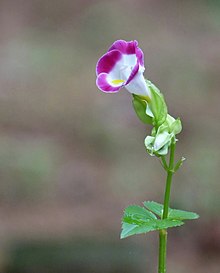| Superasterids Temporal range:
| |
|---|---|

| |
| Torenia fournieri | |
| Scientific classification | |
| Kingdom: | Plantae |
| Clade: | Tracheophytes |
| Clade: | Angiosperms |
| Clade: | Eudicots |
| Clade: | Core eudicots |
| Clade: | Superasterids |
| Clades[1] | |
The superasterids are members of a large clade (monophyletic group) of flowering plants, containing more than 122,000 species.[citation needed]
The clade is divided into 20 orders as defined in APG IV system. These orders, in turn, together comprise about 146 families.[1]
The name is based upon the name "Asteridae", which had usually been understood to be a subclass.
Relationships[edit]
The asterids, Berberidopsidales, Santalales, and Caryophyllales form the superasterids clade.[2] This is one of three groups that compose the Pentapetalae (core eudicots minus Gunnerales),[3] the others being Dilleniales and the superrosids (Saxifragales and rosids).[2]
Phylogeny[edit]
The phylogeny of superasterids shown below is adapted from the Angiosperm Phylogeny Group website.[2]
| superasterids | |
References[edit]
- ^ a b Angiosperm Phylogeny Group (2016). "An update of the Angiosperm Phylogeny Group classification for the orders and families of flowering plants: APG IV". Botanical Journal of the Linnean Society. 181 (1): 1–20. doi:10.1111/boj.12385.
- ^ a b c Peter F. Stevens (2001), Angiosperm Phylogeny Website
- ^ Philip D. Cantino; James A. Doyle; Sean W. Graham; Walter S. Judd; Richard G. Olmstead; Douglas E. Soltis; Pamela S. Soltis & Michael J. Donoghue (2007), "Towards a phylogenetic nomenclature of Tracheophyta" (PDF), Taxon, 56 (3): 822–846, doi:10.2307/25065865, JSTOR 25065865
External links[edit]
 Media related to Superasterids at Wikimedia Commons
Media related to Superasterids at Wikimedia Commons

Well, that’s interesting to know that Psilotum nudum are known as whisk ferns. Psilotum nudum is the commoner species of the two. While the P. flaccidum is a rare species and is found in the tropical islands. Both the species are usually epiphytic in habit and grow upon tree ferns. These species may also be terrestrial and grow in humus or in the crevices of the rocks.
View the detailed Guide of Psilotum nudum: Detailed Study Of Psilotum Nudum (Whisk Fern), Classification, Anatomy, Reproduction